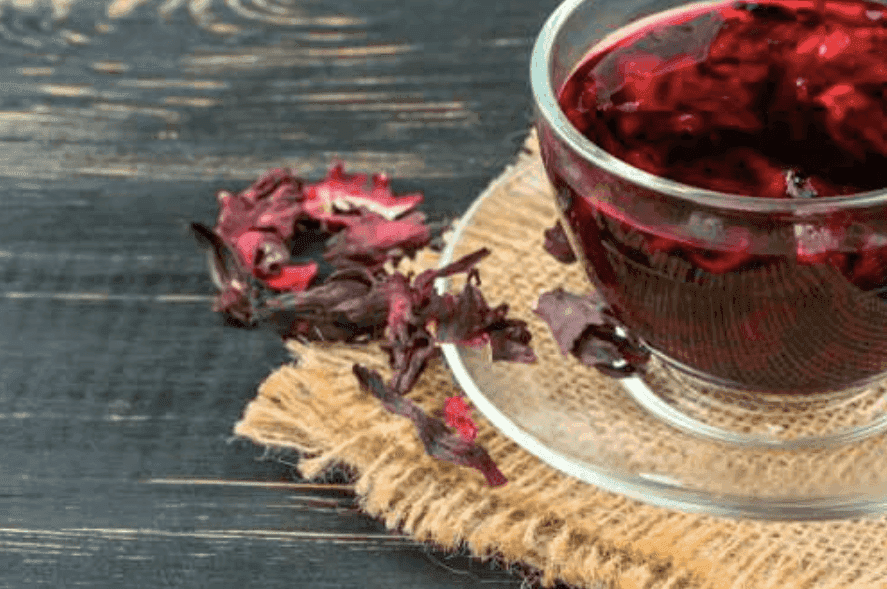Therapeutic Uses of Hibiscus in Treating Common Chronic Diseases
by Amylee Amos PhD, RDN, IFMCPNews
The Amos Institute Team is proud to have authored a recent publication in the Journal of the American College of Nutrition, entitled “Mechanisms of Action of Nutritionally Rich Hibiscus sabdariffa’s Therapeutic Uses in Common Chronic Diseases: a Literature Review.” In the article, we delineate the mechanisms for which hibiscus can be utilized as a therapeutic intervention for hypertension, diabetes, hyperlipidemia, obesity, and Alzheimer’s disease.
Hibiscus is a crimson colored flower that has been used for millennia as a cultural beverage and ancient medicinal tonic. Like many other herbs and flowers, boiled Hibiscus is often referred to as a tea, though it does not come from the Camelia sinensis plant, so technically, it is not a true tea. Throughout the world it is consumed both hot and cold. In recent research, hibiscus has been compared to commonly prescribed pharmaceuticals to determine its efficacy in treating chronic diseases. In fact, in 2018 the Amos Institute wrote a post about using hibiscus as an intervention to treat high blood pressure, in which we highlighted research that hibiscus was as effective as commonly prescribed ACE inhibitors in hypertensive patients. Since the time we wrote that post, the research in hibiscus has flourished, inspiring us to author a peer reviewed literature review of the many uses of hibiscus in some of the top chronic diseases.
Here are the major mechanisms we highlight in the publication.
Hibiscus for high blood pressure:
Hypertension, or high blood pressure, is a condition that can contribute to heart disease and stroke. Hibiscus has two primary mechanisms in regards to its anti-hypertensive effect. Hibiscus works as a vasodilator, relaxing the smooth muscle of the blood vessels. This reduces resistance in the vessels leading to a decrease in arterial blood pressure. Hibiscus also has a diuretic effect, meaning it helps the kidneys excrete sodium and water, which lowers blood pressure by decreasing the fluid volume in the body.
Hibiscus for diabetes:
Diabetes, specifically type 2 diabetes, is a metabolic condition marked by glycemic dysregulation. Subtype 1.5 Alzheimer’s disease, or glycotoxic Alzhiemer’s, is characterized by blood sugar control issues and insulin resistance, as is diabetes. The anti-diabetes effects of hibiscus stems from its ability to function as a hypoglycemic through a mechanism similar to the class of anti-diabetes drugs known as Gliptins. Hibiscus further protects cells from the toxic effects of elevated glucose. Additionally, hibiscus has an anti-insulin resistance effect, protecting metabolic health and brain health.
Hibiscus for high cholesterol:
Hibiscus can impact blood cholesterol levels, as well as diseases relating to elevated blood cholesterol through a number of ways. Hibiscus has a lowering effect on lipids that contribute to cardiovascular disease such as triglycerides, LDL cholesterol, and VLDL cholesterol, while likely not lowering the heart healthy HDL levels. In fact, some research shows that it was more effective than the common cholesterol lowering medication, Lovastatin.
Additionally, hibiscus intake directly inhibits fat accumulation in the body. Hibiscus acts as an anti-obesogenic, preventing obesity by limiting the accumulation of intracellular fats.
Hibiscus for Alzheimer’s disease:
Finally, hibiscus is a potent therapeutic intervention for preventing Alzheimer’s disease. Hibiscus can lower neuroinflammation. This is of particular note for individuals suffering or at risk of subtype 1 Inflammatory Alzheimer’s disease. Hibiscus may improve spatial memory, perhaps due to its anti-inflammatory effect. Additionally, its anti-diabetic effect can also protect against Alzheimer’s disease, as glycemic control issues contribute to Alzheimer’s pathology.
The research we cover in this paper is further evidence that food truly is medicine. If there were a pharmaceutical drug that could do all of these things, it would be flying off the shelves. It would probably cost a fortune. Yet we can reap all of these remarkable benefits by drinking a simple cup of hibiscus. Actually, from our analysis of the research, we recommend two strong cups of boiled hibiscus “tea” per day. Build hibiscus into your daily routine. It is delicious, refreshing, and best of all, protects you from chronic disease.
Reference:
Amos, A. & Khiatah, B. (2020) Mechanisms of Action of Nutritionally Rich Hibiscus sabdariffa’s Therapeutic Uses in Major Common Chronic Diseases: A Literature Review. Journal of the American College of Nutrition, https://doi.org/10.1080/07315724.2020.1848662